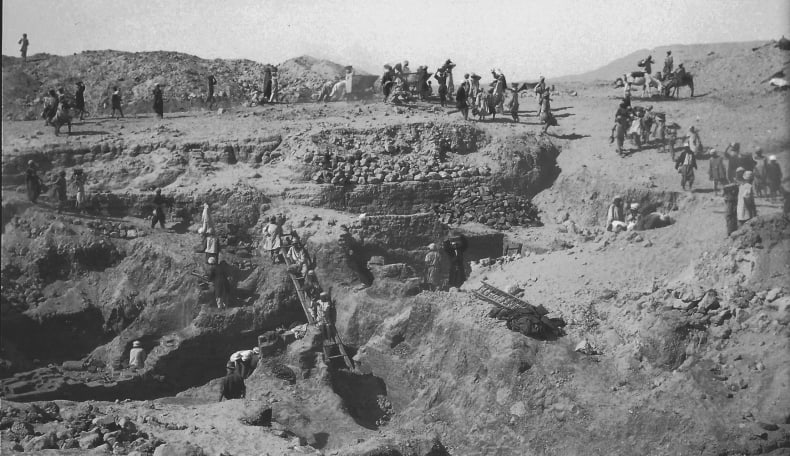Armant: the sacred bull catacombs
Armant is located on the west bank of the river Nile, 9km south-west of Luxor, known an Iuny in ancient times. The site includes some Predynastic and early A-Group cemeteries as well as a stone-built temple dedicated to the god Montu dating from the New Kingdom with substantial additions during the Late and Ptolemaic Period, including a mammissi of Cleopatra VII. The catacombs for the burials of the sacred Buchis bulls were discovered on the desert edge of the area and were in use for over 600 years from the Late Period to the Graeco-Roman Period.

Excavations of the Bucheum at Armant
The excavations at Armant were not originally financed by the Egypt Exploration Society, but began under the financial backing and direction of Sir Robert Ludwig Mond (1867- 1938) in 1926. Work was directed first by Walter Bryan Emery (1903-1971) before been taken over by Henry Frankfort (1897-1954) and then Frederick William Green (1869-1949). In 1930 the directorship passed to Oliver Humphrys Myers (1903-1966) and he continued working at Armant until 1938 when the work stopped. The Society undertook to publish the findings and financially supported some of the later work too. Though much of the site was disturbed and robbed in antiquity, many stelae were preserved and can be seen in museums around the world today.

The dig house at Armant
Gilf Kebir and Gebel Uweinat expedition
In 1938 Major Ralph Alger Bagnold (1896-1990) organised an expedition into the western deserts of Egypt to investigate dune and sand movement. He invited the Egypt Exploration Society, through the financial backing of Sir Robert Mond, to attend the survey in order to record archaeological material. The team, including Oliver Myers and Hans Alexander Winkler (1900-1945) and left the camp at Armant on 5th February 1938 and travelled to the Gilf Kebir. The records from this expedition are kept in the archives and record some of the rock inscriptions in this area of the western deserts.

A panoramic shot of the western desert taken during the Gilf Kebir expedition
Further reading
Bagnold, R A., Myers, O H., Peel, R F., and Winkler, H A. 1939. 'An expedition to the Gilf Kebir and 'Uweinat, 1938', in The Geographical Journal 93, 281-313.
Mond, R., and Myers, O. H. 1934. The Bucheum I: The history and archaeology of the site. London: The Egypt Exploration Society.
Mond, R., and Myers, O. H. 1934. The Bucheum II: The inscriptions. London: The Egypt Exploration Society.
Mond, R., and Myers, O. H. 1934. The Bucheum III: The plates. London: The Egypt Exploration Society.
Mond, R., and Myers, O. H. 1937. Cemeteries of Armant (2 vols). London: The Egypt Exploration Society.
Mond, R., and Myers, O. H. 1940. Temples of Armant: A Preliminary Survey (2 vols). London: The Egypt Exploration Society.



